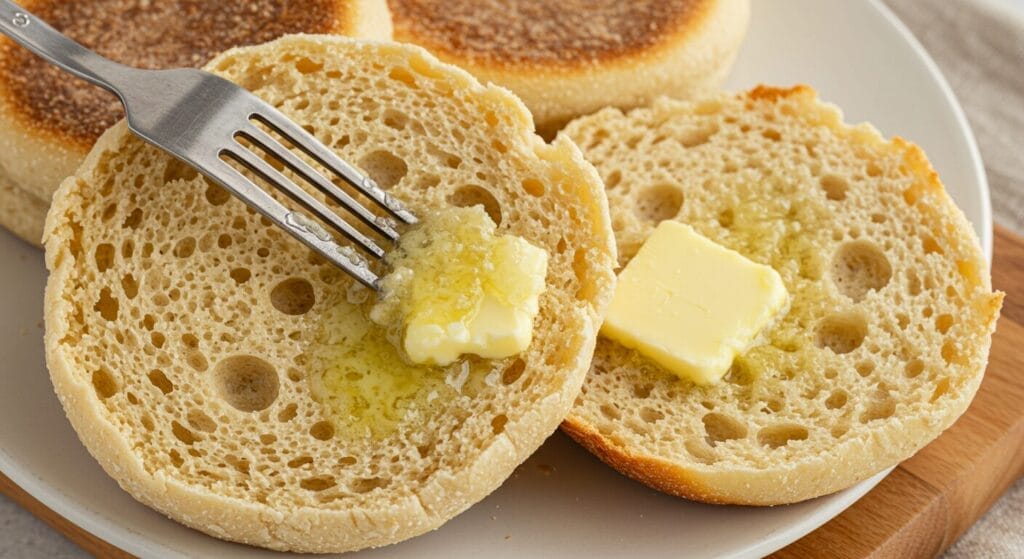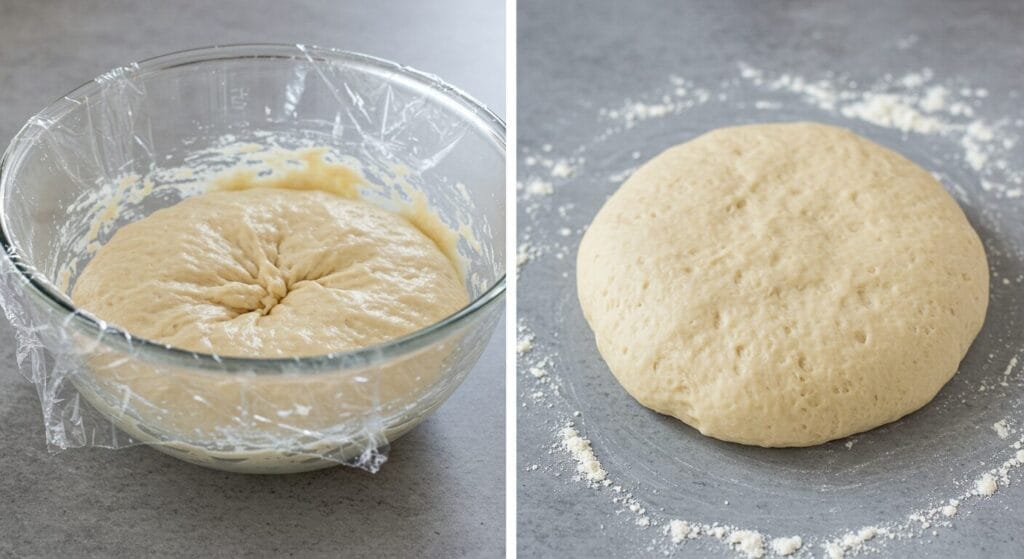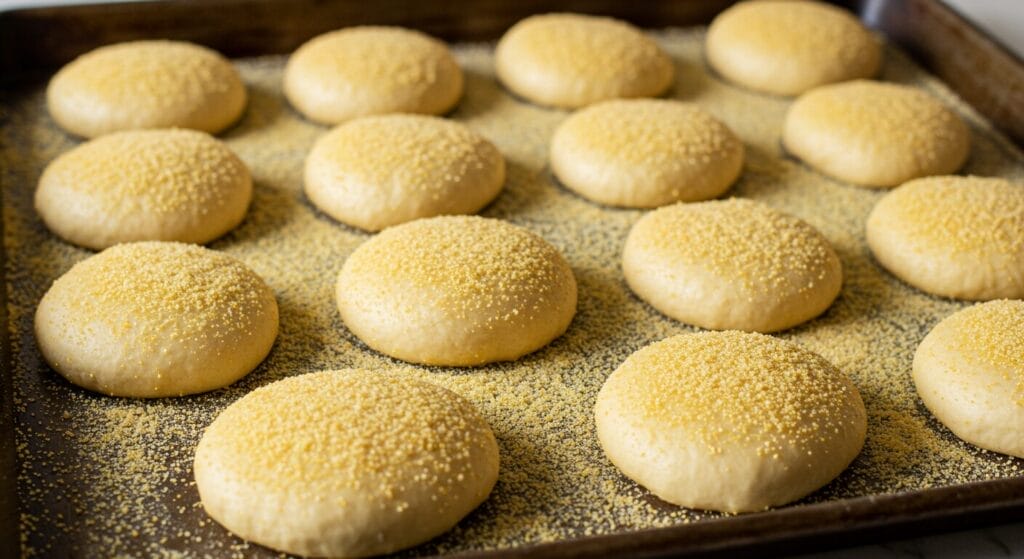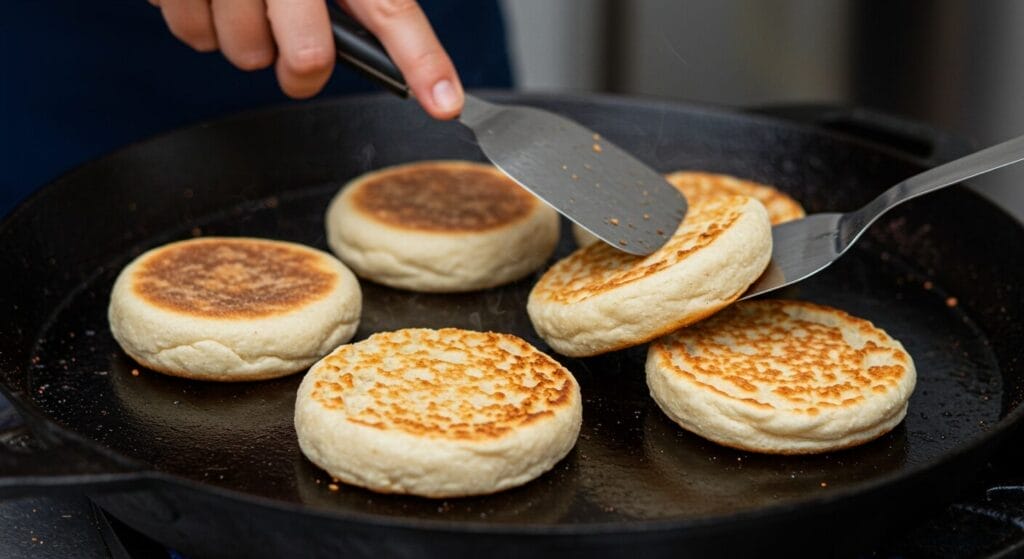The Ultimate Homemade English Muffins Recipe: Perfect Nooks & Crannies Every Time!
Hello, WiseRecipes community and fellow lovers of freshly baked breakfast delights! Is there anything more satisfying than splitting open a warm, toasted English muffin, revealing those incredible nooks and crannies, ready to cradle melted butter and jam? Today, I’m thrilled to share my Ultimate Homemade English Muffin recipe – a recipe that will make you say goodbye to store-bought versions forever!
Forget those often dense and lackluster pucks from the grocery store. We’re talking about creating truly exceptional, fluffy english muffin recipe from scratch results, with that signature chewy texture and a delightfully crisp exterior when toasted. This easy homemade english muffins with nooks and crannies guide will walk you through every step, ensuring you achieve that iconic texture that makes them so special. The joy of making your own is unparalleled!
Table of Contents
My quest to perfect this Homemade English Muffin recipe was driven by a love for that unique texture and a desire for a simpler method than some traditional, more laborious techniques. While some recipes call for extensive kneading, this version aims for ease without sacrificing quality, leaning towards a no knead english muffins (or minimal knead) approach where possible. We’ll also touch upon the concept of an best english muffin bread recipe for those who love the flavor but prefer a loaf form.
So, if you’re ready to fill your kitchen with the incredible aroma of freshly griddled muffins and learn how to get nooks and crannies in english muffins consistently, you’re in the right place. Let’s bake (and griddle!) some breakfast magic with this definitive Homemade English Muffin recipe!

Why This Homemade English Muffin Recipe is a Game-Changer
If the promise of perfect nooks and crannies isn’t enough, here’s why this Homemade English Muffin recipe is a must-try:
- Iconic Nooks & Crannies: This recipe is specifically designed to help you achieve that coveted airy, pocketed texture perfect for holding pools of butter or your favorite spreads.
- Fluffy Interior, Crispy Exterior: Get the best of both worlds – a soft, chewy inside and a wonderfully crisp, golden-brown outside when toasted. This is what makes a fluffy english muffin recipe from scratch truly special.
- Way Better Than Store-Bought: The flavor and texture of homemade are simply superior. Plus, you control the ingredients – no preservatives or artificial anything!
- Surprisingly Achievable: While making yeasted goods might seem daunting, this Homemade English Muffin recipe breaks it down into manageable steps.
- Versatile Breakfast Staple: Perfect for toasting with butter and jam, making eggs Benedict, breakfast sandwiches, or even mini pizzas.
- The Joy of Homemade: There’s immense satisfaction in creating these classic breakfast treats from scratch in your own kitchen.
Gather Your Baking Essentials: Ingredients for Perfect English Muffins
Let’s get our simple yet crucial ingredients ready for this delightful Homemade English Muffin recipe.
Key Ingredients (Makes approx. 10-12 English Muffins):
- All-Purpose Flour: 3 ½ cups (approx. 420g), plus more for dusting. Bread flour can also be used for a slightly chewier result.
- Instant Yeast (or Active Dry Yeast): 2 ¼ teaspoons (1 standard packet). If using active dry yeast, proof it first in warm water with a pinch of sugar.
- Granulated Sugar: 1 tablespoon.
- Salt: 1 teaspoon.
- Warm Milk (105-115°F / 40-46°C): 1 cup. Dairy or unsweetened plant-based milk works.
- Warm Water (105-115°F / 40-46°C): ½ cup.
- Unsalted Butter: 2 tablespoons, melted and slightly cooled (plus more for greasing the griddle).
- Cornmeal or Semolina Flour: For dusting the baking sheet and griddle. This prevents sticking and adds to the classic texture.
Crafting Your Masterpiece: Step-by-Step to Nook-and-Cranny Perfection
Let’s embark on our Homemade English Muffin recipe journey!
Step 1: Activate Yeast & Mix Dough (If using Active Dry Yeast, proof it first)
- Combine Dry Ingredients: In a large mixing bowl, whisk together 3 cups of the all-purpose flour, instant yeast (if using instant), sugar, and salt.
- Combine Wet Ingredients: In a separate bowl or measuring cup, combine the warm milk, warm water, and melted butter.
- Form Dough: Pour the wet ingredients into the dry ingredients. Mix with a wooden spoon or a stand mixer fitted with a dough hook on low speed until a shaggy dough begins to form.
- Add Remaining Flour & Knead (Minimal Knead Approach): Gradually add the remaining ½ cup of flour, mixing until the dough pulls away from the sides of the bowl. The dough will be quite soft and slightly sticky – this is normal for English muffins and contributes to the easy homemade english muffins with nooks and crannies.
Turn the dough out onto a lightly floured surface. Knead gently for just 3-5 minutes, just until it becomes a bit smoother. Avoid over-kneading; we’re not looking for intense gluten development like in some bread. This minimal effort is key to a simpler Homemade English Muffin recipe.

Step 2: First Rise (Bulk Fermentation)
- Prepare Bowl: Lightly grease a large bowl with oil or butter.
- Let it Rise: Place the kneaded dough into the greased bowl, turning it once to coat the top. Cover the bowl tightly with plastic wrap or a damp kitchen towel.
- Rise Time: Let the dough rise in a warm, draft-free place for 1 to 1.5 hours, or until it has almost doubled in size. The exact time will depend on the warmth of your kitchen. This rise is crucial for the fluffy english muffin recipe from scratch.
Step 3: Shape the Muffins
- Prepare Baking Sheet: Sprinkle a large baking sheet generously with cornmeal or semolina flour.
- Divide Dough: Gently deflate the risen dough by pressing it down. Turn it out onto a lightly floured surface. Divide the dough into 10-12 equal pieces (each about 2.5-3 oz).
- Shape into Rounds: Gently roll each piece into a smooth ball, then flatten it into a disc about 3-3.5 inches in diameter and about ½-inch thick. Try to handle the dough gently to preserve the air bubbles that will become those glorious nooks and crannies.
- Place on Baking Sheet: Arrange the shaped muffins on the prepared cornmeal-dusted baking sheet, leaving some space between them. Sprinkle the tops of the muffins lightly with more cornmeal.

Step 4: Second Rise (Proofing)
- Cover and Rise Again: Loosely cover the baking sheet with plastic wrap or a light kitchen towel.
- Proof Time: Let the muffins rise in a warm place for another 30-45 minutes, or until they look puffy and have increased in size by about 50%. They won’t double again. This step contributes to the light texture of your Homemade English Muffin recipe.
Step 5: Cook the English Muffins on a Griddle
- Preheat Griddle: Heat a large, dry (un-greased, unless your griddle tends to stick badly, then a tiny wipe of butter) cast-iron skillet, electric griddle, or heavy-bottomed frying pan over low to medium-low heat. The heat should be gentle; too high, and the outsides will burn before the insides cook. This is a key part of how to get nooks and crannies in english muffins – slow, even cooking.
- Cook in Batches: Carefully transfer a few muffins at a time to the hot griddle, leaving space between them.
- Cook First Side: Cook for about 5-8 minutes per side. The first side should be nicely golden brown and the muffin should start to puff up a bit.
- Flip and Cook Second Side: Gently flip the muffins using a thin spatula and cook the other side for another 5-8 minutes, until golden brown and cooked through. The sides of the muffins should also look cooked, not doughy. The internal temperature should be around 200°F (93°C).
- Cool: Transfer the cooked English muffins to a wire rack to cool completely. Repeat with the remaining dough.

Step 6: Split and Toast (The Grand Reveal!)
- Split, Don’t Cut: Once cooled, the traditional way to open an English muffin to reveal the best nooks and crannies is to split it horizontally with a fork. Insert the tines of a fork all around the circumference of the muffin, then gently pull the halves apart. This preserves the texture. Slicing with a knife can compress those precious air pockets.
- Toast to Perfection: Toast the split English muffins until golden brown and crispy.
- Enjoy: Serve your amazing Homemade English Muffin recipe creations warm with plenty of butter, jam, honey, or as the base for eggs Benedict or a breakfast sandwich!
Wise Tips for Nook-and-Cranny Nirvana
Achieve English muffin perfection with these essential tips for your Homemade English Muffin recipe:
- Slightly Sticky Dough is Good: Don’t be tempted to add too much extra flour during kneading. A softer, slightly stickier dough helps create an airier texture and better nooks.
- Gentle Handling: After the first rise, handle the dough gently when dividing and shaping to avoid deflating all the air bubbles you’ve developed.
- Low and Slow Griddle Heat: This is crucial. Cooking English muffins too quickly will result in a burnt exterior and a raw, doughy interior. Patience on a low to medium-low griddle is key.
- Cornmeal is Your Friend: It not only prevents sticking but also adds that classic texture and a slight crunch to the exterior of your Homemade English Muffin recipe.
- Fork-Splitting for Texture: Always split your cooled English muffins with a fork, not a knife, to maximize those beautiful nooks and crannies.
- Cool Completely Before Splitting: Attempting to split them while warm can make them tear unevenly.
Delicious Variations & English Muffin Bread
This Homemade English Muffin recipe is a wonderful base:
- Cinnamon Raisin English Muffins: Knead in ½ cup of raisins and 1 teaspoon of cinnamon with the last additions of flour.
- Whole Wheat English Muffins: Replace up to half of the all-purpose flour with whole wheat flour for a heartier muffin. You may need to add a little extra liquid.
- Sourdough English Muffins: For a tangy flavor, incorporate your active sourdough starter. This requires adjusting yeast and flour quantities (a more advanced variation).
- English Muffin Bread: Love the flavor but prefer a loaf? Many best english muffin bread recipe variations exist. Typically, the dough is similar but baked in a loaf pan, then sliced and toasted to reveal a texture reminiscent of English muffins. This is a great alternative if you don’t want to griddle individual muffins.
Storing Your Homemade Treasures
Enjoy your Homemade English Muffin recipe creations for days!
- Storage: Once completely cooled, store English muffins in an airtight container or resealable bag at room temperature for up to 3-4 days.
- Freezing: For longer storage, English muffins freeze beautifully. Split them first (optional, but convenient), then wrap tightly in plastic wrap and place in a freezer bag or freezer-safe container. Freeze for up to 3 months.
- Reheating/Toasting from Frozen: You can toast frozen English muffin halves directly from the freezer; just add a little extra toasting time.
Frequently Asked Questions (FAQ) – Homemade English Muffin Recipe
Your common questions about crafting the perfect homemade English muffin:
- Why don’t my English muffins have many nooks and crannies?
Several factors contribute: a relatively wet/soft dough, gentle handling after the first rise, proper proofing (second rise), and fork-splitting. Over-kneading or handling the dough too roughly can deflate air bubbles. Ensure your yeast is active too for a good rise in your Homemade English Muffin recipe. - Can I make this recipe entirely no-knead?
Yes, many no knead english muffins recipes exist. They typically involve a very wet dough and longer fermentation times, often mixed and then left to rise for 12-18 hours. This recipe aims for a simpler, quicker minimal-knead approach, but you can certainly adapt it or find dedicated no-knead versions. - What’s the best way to tell if my English muffins are cooked through on the griddle?
Besides being golden brown on both sides, they should feel fairly firm to the touch and sound slightly hollow when tapped. An internal temperature of 200-210°F (93-99°C) is a sure sign they are done. - Can I bake these English muffins instead of griddling them?
Traditional English muffins are griddled for their characteristic flat tops and bottoms and slightly chewy crust. Baking will result in a different texture, more like a regular roll or small bun. If you wish to bake, try around 375°F (190°C) for 15-20 minutes. - My griddle is making them too dark on the outside before the inside is cooked. What should I do?
Your griddle heat is too high. Lower the temperature significantly. English muffins need slow, gentle heat to cook through evenly.
This Homemade English Muffin recipe is a true labor of love that yields incredibly rewarding results. The satisfaction of creating your own batch of easy homemade english muffins with nooks and crannies is immense. From a simple toasted treat with butter to the base of an elaborate eggs Benedict, these muffins are a versatile delight.
I’m so excited for you to embark on your English muffin-making adventure! If you try this fluffy english muffin recipe from scratch, please come back and share your experience in the comments. Were your nooks and crannies epic? Happy baking (and griddling)!




